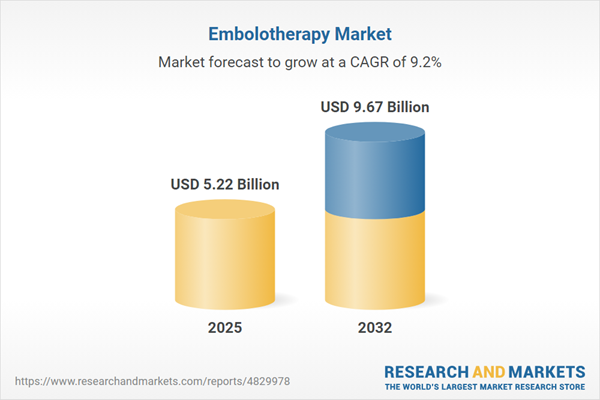Speak directly to the analyst to clarify any post sales queries you may have.
The embolotherapy market, driven by breakthroughs in minimally invasive procedures and enhanced digital infrastructure, is enabling leading healthcare providers to achieve greater operational agility and improved clinical performance. Senior stakeholders seeking actionable insights benefit from advanced market intelligence that supports strategic decisions and robust adaptation to regulatory shifts.
Market Snapshot: Embolotherapy Market
The embolotherapy market continues to register strong growth, supported by a solid valuation and consistent annual progress. The adoption of personalized medical solutions and innovative, minimally invasive techniques is reshaping patient care, positioning healthcare providers to operate more efficiently while delivering responsive interventions. Hospitals and clinics are at the forefront, integrating advanced digital imaging systems and procedural technologies which enhance clinical pathways and help support a stronger focus on patient-centric outcomes. Interdisciplinary collaboration is further simplifying workflows and encouraging increased investment in health IT. As treatment models evolve, the sector’s ability to leverage these innovations is essential to strengthening organizational competitiveness and meeting emerging patient needs in a dynamic healthcare environment.
Scope & Segmentation: Embolotherapy Market
A comprehensive analysis of embolotherapy market segments enables decision-makers to make informed, data-driven planning choices and reinforce organizational resilience as clinical and regulatory frameworks advance.
- Product Types: This segment encompasses balloon catheters and vascular plugs, which are key in acute, ambulatory, and outpatient procedures. It also includes embolic coils, liquid embolics, and particle embolics, broadening the technological scope to manage a wide variety of complex or specialized medical indications.
- Applications: Solutions span from neurovascular embolization and tumor management to peripheral vascular procedures. Notably, the segment also addresses uterine fibroid ablation, chemoembolization, and radioembolization, highlighting value propositions across neurology, oncology, and gynecology. Increasing multidisciplinary application extends reach and clinical impact.
- End Users: Key settings include hospitals, ambulatory surgical centers, oncology clinics, and facilities specializing in vascular intervention. The continuous uptake across these user groups sustains demand, ensuring care delivery can adapt seamlessly to evolving patient and operational needs.
- Regions: Geographic coverage spans the Americas, Europe, Middle East and Africa, and Asia-Pacific. Regional variations reflect divergent regulatory practices and digital health strategies, with major markets such as the United States, United Kingdom, China, and India accelerating digital innovation and regional expansion opportunities.
- Leading Companies: Boston Scientific Corporation, Terumo Corporation, and Medtronic plc are principal players driving the sector. Additional firms including Johnson & Johnson, Becton, Dickinson and Company, Merit Medical Systems, Cook Medical, Penumbra, MicroVention, and Asahi Intecc contribute technological advancement and foster market diversity.
Key Takeaways for Senior Decision-Makers
- Minimally invasive embolotherapy modalities streamline clinical workflows, helping organizations reduce patient recovery intervals and maintain uninterrupted care delivery.
- Advanced digital imaging and planning platforms elevate procedural precision, foster coordination among medical specialties, and support robust, integrated care models.
- Diversified supplier strategies improve resilience, securing continuous device availability and better preparing procurement teams to navigate variable supply chains and regulatory conditions.
- Ongoing engagement with regulatory bodies supports both efficient compliance and smooth incorporation of new interventions or industry guidelines.
- Active alliances among manufacturers, clinical institutions, and biotech innovators bolster ongoing progress and enable refinement of best practices across care delivery.
- Adaptable outpatient and ambulatory operations allow healthcare organizations to respond rapidly to patient volume shifts while preserving consistent standards across diverse settings.
Tariff Impact: Navigating Regulatory and Supply Chain Changes
Recent changes to U.S. tariffs are prompting healthcare organizations to reassess device sourcing strategies within the embolotherapy market. Senior decision-makers are reviewing supplier relationships and exploring alternative sources for essential polymers and specialty materials in response to evolving conditions. This environment encourages a pivot toward domestic manufacturing and increased supplier diversity, supporting stable device access, strategic cost control, and continued operational reliability as regulatory policies fluctuate.
Methodology & Data Sources
This report synthesizes secondary market research with direct insights collected from healthcare stakeholders. Evidence used in this analysis includes clinical trial results, policy reviews, evaluations of procurement and reimbursement trends, and direct industry feedback. By triangulating these sources, actionable and robust market intelligence is provided for informed decision-making.
Why This Report Matters for B2B Decision-Makers
- Enables executive teams to track embolotherapy market evolution and align operational strategies with regulatory change for better investment planning.
- Supports targeted identification of opportunities for product innovation and geographic expansion, enhancing competitiveness in rapidly changing healthcare sectors.
- Facilitates strong alignment with technological and clinical trends, allowing organizations to optimize resources and proactively address future requirements.
Conclusion
Embolotherapy market progress is anchored in technology, collaboration, and responsive strategies. Senior leadership can leverage these insights to enhance care pathways and sustain improvements in health service delivery.
Additional Product Information:
- Purchase of this report includes 1 year online access with quarterly updates.
- This report can be updated on request. Please contact our Customer Experience team using the Ask a Question widget on our website.
Table of Contents
3. Executive Summary
4. Market Overview
7. Cumulative Impact of Artificial Intelligence 2025
Companies Mentioned
The companies profiled in this Embolotherapy market report include:- Boston Scientific Corporation
- Terumo Corporation
- Medtronic PLC
- Johnson & Johnson
- Becton, Dickinson and Company
- Penumbra, Inc.
- Merit Medical Systems, Inc.
- Cook Medical LLC
- MicroVention, Inc.
- Asahi Intecc Co., Ltd.
Table Information
| Report Attribute | Details |
|---|---|
| No. of Pages | 187 |
| Published | November 2025 |
| Forecast Period | 2025 - 2032 |
| Estimated Market Value ( USD | $ 5.22 Billion |
| Forecasted Market Value ( USD | $ 9.67 Billion |
| Compound Annual Growth Rate | 9.1% |
| Regions Covered | Global |
| No. of Companies Mentioned | 11 |









